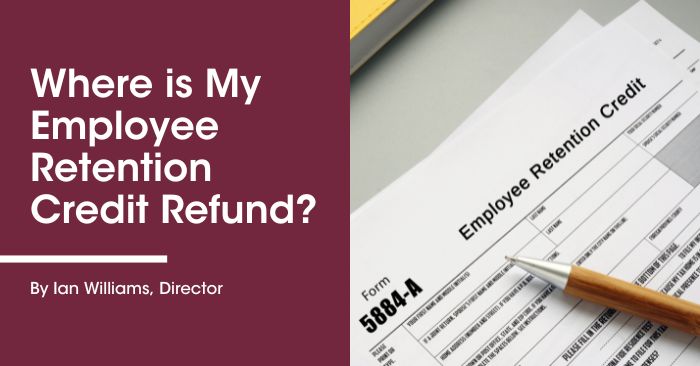Where is My Employee Retention Credit Refund?
By Ian Williams, Director, Research & Development Tax Credits and Employee Retention Credits | KBKG
The Employee Retention Tax Credit (ERTC or ERC) was introduced by the US government as a response to the economic impact of the COVID-19 pandemic. The ERC is a refundable tax credit that was designed to encourage employers to keep their employees on payroll during the pandemic. ERC refunds are claimed via an amended payroll tax return, Form 941-X, for each applicable qualifying quarter in 2020 and 2021. There has consistently been a long processing time due to a backlog of claims at the Internal Revenue Service (IRS), leading to questions from Taxpayers on the overall filing process, how to check in on the status of the refund, and how the refund will be paid out.
How do I Check on the Status of My 941-X / ERC Refund?
Employers who have claimed the Employee Retention Tax Credit (ERC) and are waiting for their refund can check the status of their return through two primary methods as noted on the IRS “Where’s My Refund?” website, specifically the Business Tax Return section. Typically, it takes the IRS at least six months to process refund requests.
1. Phone: Business Tax Return Information: For refund information on federal tax returns other than Form 1040, U.S. Individual Income Tax Return, call, toll free, at 800-829-4933. From outside the U.S., call 267-941-1000. TTY/TDD: 800-829-4059.
2. Consultation: Employers who have hired a tax professional to assist with their ERC can ask their tax professional to check the status of their refund via Power of Attorney.
How Will I Receive the Refunds:
It is important to note that when Form 941-X refund requests are processed by the IRS, each quarterly Form 941-X is processed separately. Once the forms are processed, the IRS typically mails a check accompanied by a Notice CP210, which outlines the specifics of the amounts included on the check (see summary below). Businesses with Form 941-Xs in process will need to check their mail regularly to avoid a lost or misplaced refund check, these refunds will not be electronically deposited.
Understanding the Refund Summary (Notice CP210) – Why does the refund check not match the credit on the 941-X?
Mechanics of the Form 941-X refund claim for ERC require you to split the credit between a non-refundable (941-X, Line 18a) and refundable portion (941-X, Line 26a). Businesses that did not withhold payroll taxes in advance will still receive the combined amount of these two amounts (Form 941-X, Line 27). The IRS categorizes the non-refundable portion of these refunds as a “Tax-Decrease” on the Notice CP210, and the refundable portion as “Credits – Increase”. The amount of the IRS check will be calculated as follows:
Notice CP210 Summary Categories
- Amount due on account before adjustment
- Tax – Decrease (From 941-X, Line 18a)
- Credits – Increase (From 941-X, Line 26a)
- Credit interest allowed
- Overpayment (Total on the check)
Additional information on Notice CP210 can be found here: https://www.irs.gov/individuals/understanding-your-cp210-or-cp220-notice
What if I received a check without a Notice CP210?
If the IRS sends a check without the accompanying Notice CP210, the bottom of the check includes a few memos that will help you reconcile the amounts to your Form 941-X.
Refund Check Memos (bottom of check):
- Processing Center (e.g., Ogden)
- Tax Period (e.g., 09/2021)
- Tax Form (e.g., F-941)
- Interest and number of days of interest (e.g., $1,000.01 INT, 065 days)
- If there was no outstanding tax liability, the check amount should be Form 941-X, Line 27, plus any interest noted on the check memo.
Tax Return Adjustments
An employer’s deduction for qualified wages, including qualified health plan expenses, must be reduced by the amount of the employee retention credit. Effectively, this taxes the credit, but on an amended tax return.
According to Notice 2021-49, the IRS confirmed that the reduced deduction for qualified wages must take place in the tax year when they were paid or incurred.
In other words, taxpayers should file a 2020 amended federal income tax return (or administrative adjustment request (AAR), if applicable) to reduce deductions for any 2020 employee retention credits. Similarly, they should file a 2021 amended return to adjust for any 2021 employee retention credits.
Conclusion
Remember that it is important to know that the ERC refund process can take longer than expected. This is due to the backlog of claims at the IRS. Therefore, employees should periodically check the status of their return. They should also be prepared for a potentially lengthy wait time, which is typically at least six months. In case of any issues or errors with the return, the IRS may contact the employer via mail. Employees may request further documentation from the employer. Employers should respond to any requests from the IRS promptly to avoid further delays in receiving their refund.
Related Articles
- KBKG Tax Insight: IRS warns Taxpayers of Improper Employee Retention Credit Claims and ERC Mills
- KBKG Tax Insight: IRS To Target Abusive ERTC Claims. Analysis of Government Shutdown & Supply Chain Rules
- It’s Not Too Late to Claim Employee Retention Tax Credits
- The Employee Retention Tax Credit (ERC): What Small Businesses Need to Know
About the Author
 Iam Williams – Director – Research And Development Tax Credit Services
Iam Williams – Director – Research And Development Tax Credit Services
Atlanta, GA
Ian Williams is a Director for KBKG, specializing in Research & Development Tax Credits and Employee Retention Credits. Ian spent eleven years at a Big Four accounting firm specializing in R&D tax credits and fixed asset studies across a variety of industries. He has extensive experience in software, heavy manufacturing, aerospace, automotive, and consumer products industries, as well as defending credit claims with the IRS. Ian earned his bachelor’s and Master’s degrees in Accounting from Samford University and is a Georgia licensed CPA and member of the AICPA.» Full Bio


